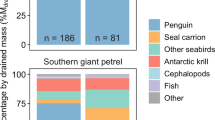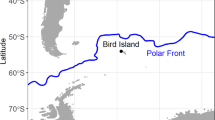Abstract
Associations between amphipods and mollusks are known from several examples, but the possible life-history strategies these amphipods utilize are often unknown. We present here the autecology of the stenothoid amphipod Metopa glacialis, an associate of the mytilid bivalve Musculus discors. Samples collected from northeast Spitsbergen of 279 M. discors show a prevalence of M. glacialis in 75%, with a variation between 1 and 41 amphipods within one mussel, the mean being 3.7. The associated amphipods have been analysed for several life-history traits such as size distributions, brood sizes and cohort compositions. Analyses of fatty acid composition of the associated species indicate different food sources for the amphipods and mollusks. Based on our data we propose two possible life-history strategies for M. glacialis: 3 or more seasons of single broods and parental care over more than 1 year after hatching, or multiple broods in one season and extended parental care. To our knowledge multiple broods in one season and extended parental care have never been reported in arctic amphipods.






Similar content being viewed by others
References
Arndt CE, Swadling KM (2006) Crustacea in Arctic and Antarctic sea ice: distribution, diet and life history strategies. Adv Mar Biol 51:197–315
Bellan-Santini D (1990) Nouvelles espèces d’Orchomene s. l. (Crustacea–Amphipoda) des fonds abyssaux. Affinités avec les autres Orchomene profonds. Beaufortia 41:15–23
Branch GM (1975) The ecology of Patella from the Cape Peninsula South Africa. Zool Afr 10:133–162
Dalsgaard J, St. John M, Kattner G et al (2003) Fatty acid trophic markers in the pelagic marine environment. Adv Mar Biol 46:225–340
Dempster AP, Laird NM, Rubin DB (1977) Maximum likelihood from incomplete data via the EM algorithm. J R Stat Soc B 39:1–38
Du J (2002) Combined algorithms for fitting finite mixture distributions. MS thesis, McMaster University, Hamilton, Ontario
Dunbar MJ (1954) The amphipod Crustacea of Ungava Bay, Canadian eastern Arctic. J Fish Res Board Can 11:709–798
Falk-Petersen S, Sargent JR, Henderson J et al (1998) Lipids and fatty acids in ice algae and phytoplankton from the Marginal Ice Zone in the Barents Sea. Polar Biol 20:41–47
Goës A (1866) Crustacea amphipoda maris Spetsbergiam alluentis, cum speciebus aliis arcticis enumerat. Öfvers K Vet Akad Förh 1865:517–536
Graeve M, Kattner G, Piepenburg D (1997) Lipids in arctic benthos: does the fatty acid and alcohol composition reflect feeding and trophic interactions? Polar Biol 18:53–61
Greenslade PJM (1983) Adversity selection and the habitat templet. Am Nat 122:352–365
Hansen HJ (1888) Malacostraca marina Groenlandiæ occidentalis. Oversigt over det vestlige Grønlands Fauna af malakostrake Havkrebsdyr. Vidensk Medd Dan Naturhist For 1887:5–226
Just J (1983) Anonyx affinis (Crust., Amphipoda: Lysianassidae), commensal in the bivalve Musculus laevigatus, with notes on Metopa glacialis (Amphipoda: Stenothoidae). Astarte 12:69–74
Krøyer H (1842) Nye nordiske Slægter og Arter af Amfipodernes Orden, henhørende til Familien Gammarina. Naturhist Tidsskr 4:141–166
MacDonald P, Green P (1988) Users guide to Program MIX: an interactive program for fitting mixtures of distribution. Ichthus Data Systems, Hamilton, ON
MacDonald PDM, Pitcher TJ (1979) Age-groups from size–frequency data: a versatile and efficient method for analyzing distribution mixtures. J Fish Res Board Can 36:987–1001
Meier S, Mjøs SA, Joensen H et al (2006) Validation of a one-step extrication/methylation method for determination of fatty acids and cholesterol in marine tissues. J Chromatogr A 1104:291–298
Mjøs S (2004a) The prediction of fatty acid structure from selected ions in electron impact mass spectra of fatty acid methyl esters. Eur J Lipid Sci Technol 106:550–560
Mjøs S (2004b) Two-dimensional fatty acid retention indices. J Chromatogr A 1061:201–209
Nelson WG (1980) Reproductive patterns in gammaridean amphipods. Sarsia 65:61–71
Nygård H, Vihtakari M, Berge J (2009) Life history of Onisimus caricus (Amphipoda: Lysianassoidea) in a high Arctic fjord. Aquat Biol 5:63–74
Nyssen F, Brey T, Dauby P et al (2005) Trophic position of Antarctic amphipods—enhanced analysis by a 2-dimensional biomarker assay. MEPS 300:135–145
Ockelmann WK (1958) The Zoology of East Greenland: marine Lamellibranchiata. Medd Grønl 122:1–256
Ockelmann WK (1983) Descriptions of Mytilid species and definition of the Dacrydiinae n. subfam. (Mytilacea–Bivalvia). Ophelia 22:81–123
Oldevig H (1959) Arctic, subarctic and Scandinavian amphipods in the collections of the Swedish Natural History Museum in Stockholm. Medd Göteb Mus Zool Avd 127:1–132
Poulin R, Hamilton WJ (1995) Ecological determinants of body size and clutch size in amphipods: a comparative approach. Funct Ecol 9:364–370
Sainte-Marie B (1991) A review of the reproductive bionomics of aquatic gammaridean amphipods: variation in life history traits with latitude, depth, salinity and superfamily. Hydrobiologia 223:189–227
Shoemaker CR (1955) Amphipoda collected at the Arctic Laboratory, Office of Naval Research, Point Barrow, Alaska, by G. E. MacGinitie. Smithson Misc Coll 128:1–78
Smetacek V, Nicol S (2005) Polar ocean ecosystems in a changing world. Nature 437:362–368
Søreide J, Leu E, et al (2010) Timing of blooms, algal food quality and Calanus glacialis reproduction and growth in a changing Arctic (submitted)
Steele DH, Steele VJ (1973) The biology of Gammarus (Crustacea, Amphipoda) in the northwestern Atlantic. VII. The duration of embryonic development in five species at various temperatures. Can J Zool 51:995–999
Steele DH, Steele VJ (1975) Egg size and duration of embryonic development in Crustacea. Int Revue Ges Hydrobiol 60:711–715
Stephensen K (1944) The zoology of East Greenland. Amphipoda. Medd Grønl 121:1–165
Stephensen K, Thorson G (1936) On the amphipod Metopa groenlandica H. J. Hansen found in the mantle cavity of the lamellibranchiate Pandora glacialis Leach in East Greenland. Medd Grønl 118:1–7
Tandberg AHS, Vader W (2009) A redescription of Metopa species (Amphipoda, Stenothoidae) based on the type material. 1. Zoological Museum, Copenhagen (ZMUC). Zootaxa 2093:1–36
Tandberg AHS, Schander F, Pleijel F (2010) First record of the association between the amphipod Metopa alderii and the bivalve Musculus. Mar Biodiv Rec 3:e5. doi:10.1017/S1755267209991102
Tebble N (1966) British bivalve seashells. British Museum, London
Thiel M (1999a) Host-use and population demographics of the ascidian-dwelling amphipod Leucothoe spinicarpa: indication for extended parental care. J Nat Hist 33:193–206
Thiel M (1999b) Duration of extended parental care in marine amphipods. J Crust Biol 19:60–71
Thiel M (2000) Population and reproductive biology for two sibling amphipod species from ascidians and sponges. Mar Biol 137:661–674
Thiel M (2007) Social behaviour of parent–offspring groups in crustaceans. In: Duffy JE, Thiel M (eds) Evolutionary ecology of social and sexual systems: crustaceans as model organisms. Oxford Univ Press, pp 294–318
Thomas JD, Klebba KN (2007) New species and host associations of commensal leucothoid amphipods from coral reefs in Florida and Belize (Crustacea: Amphipoda). Zootaxa 1494:1–44
Vader W (1972) Associations between amphipods and molluscs. A review of published records. Sarsia 48:13–18
Vader W (1995) Liljeborgia species (Amphipoda, Liljeborgiidae) as associates of hermit crabs. Pol Arch Hydrobiol 42:517–525
Vader W, Beehler CL (1983) Metopa glacialis (Amphipoda, Stenothoidae) in the Barents and Beaufort Seas, and its association with the lamellibranchs Musculus niger and M. discors s. l. Astarte 12:57–61
Van Dolah RF, Bird E (1980) A comparison of reproductive patterns in epifaunal and infaunal gammaridean amphipods. Estuar Coast Mar Sci 11:593–604
Weslawski J, Legezynska J (2002) Life cycles of some Arctic amphipods. Pol Polar Res 23:253–264
Weslawski J, Opalinski K, Legezynska J (2000) Life cycle and reproduction of Onisimus litoralis (Crustacea Amphipoda): The key species in the Arctic soft sediments littoral. Pol Arch Hydrobiol 47:585–596
Wiktor J (1999) Early spring microplankton development under fast ice covered fjords of Svalbard, Arctic. Oceanologia 41:51–72
Wildish DJ (1982) Evolutionary ecology of reproduction in gammaridean Amphipoda. Int J Inv Repr 5:1–19
Acknowledgments
The authors would like to thank the Norwegian Research Council for financial support of AHT, and the University Studies at Svalbard for cruise-time. M. Thiel, K. N. White and two anonymous reviewers came with valuable comments and suggestions to earlier versions of this manuscript. A.H.T. would like to thank IRIS biomiljø for use of their lab time in the Ny Ålesund Marine Lab. S. Mjøs, Nofima BioLab, kindly helped with the lipid analyses and H. Nygård helped with statistical analyses.
Author information
Authors and Affiliations
Corresponding author
Rights and permissions
About this article
Cite this article
Tandberg, A.H.S., Vader, W. & Berge, J. Studies on the association of Metopa glacialis (Amphipoda, Crustacea) and Musculus discors (Mollusca, Mytilidae). Polar Biol 33, 1407–1418 (2010). https://doi.org/10.1007/s00300-010-0833-9
Received:
Revised:
Accepted:
Published:
Issue Date:
DOI: https://doi.org/10.1007/s00300-010-0833-9




